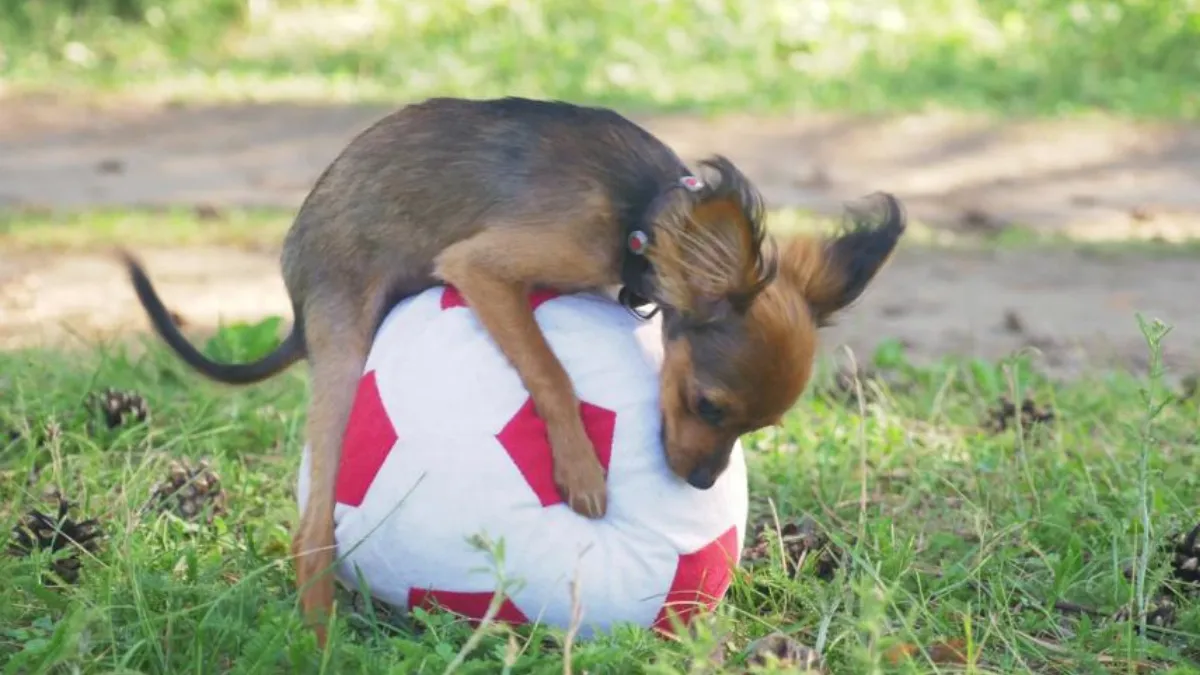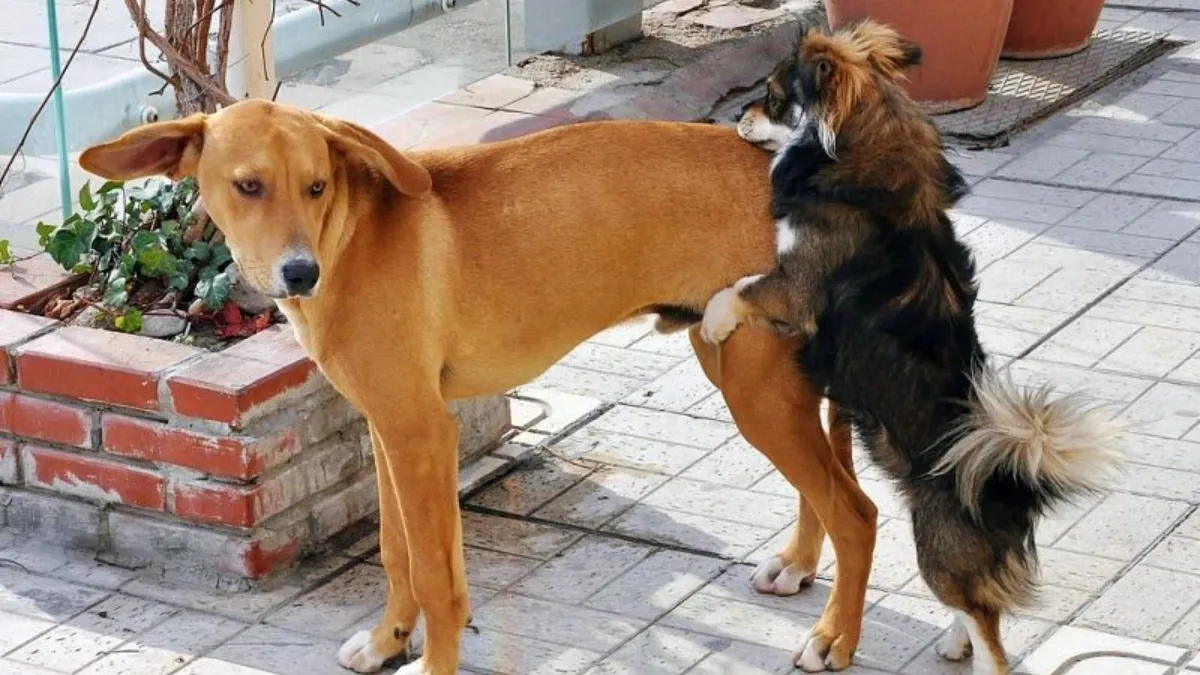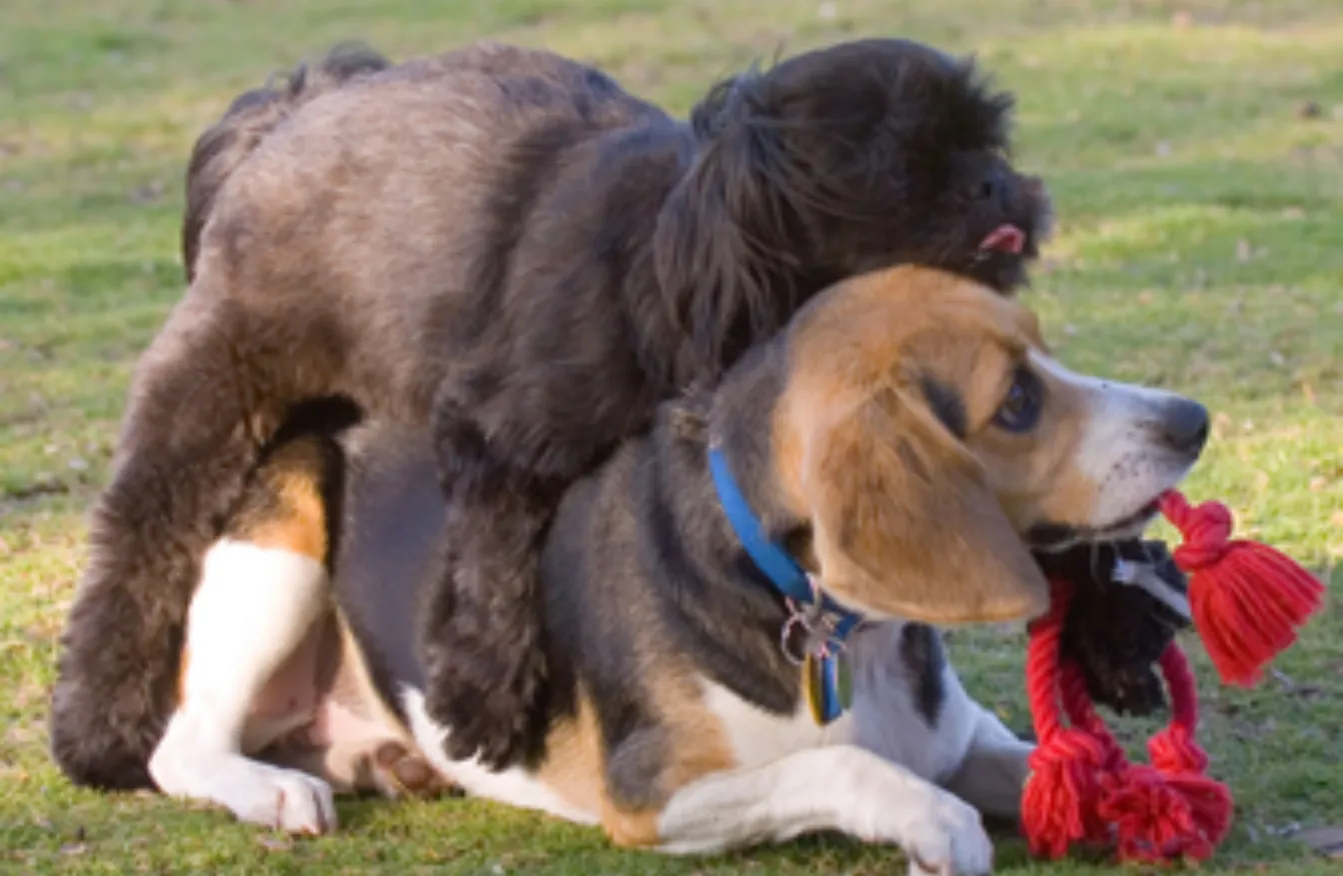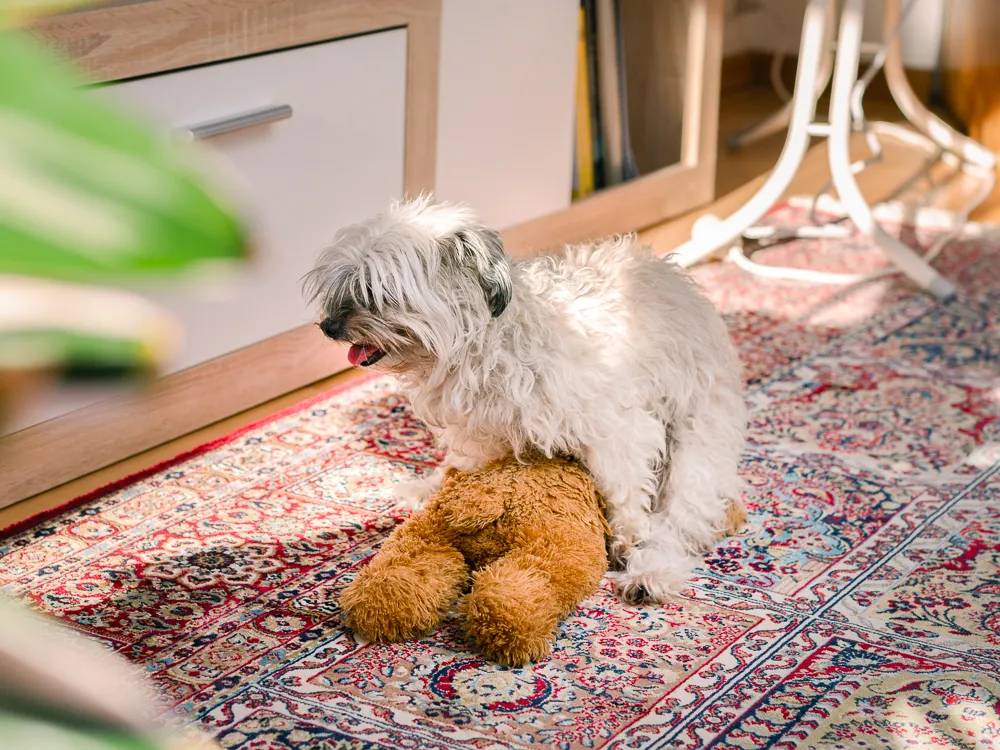Dogs are known for their quirky and sometimes bizarre behaviors. One such behavior that many dog owners have witnessed is their dog humping their leg or another object. While it may seem awkward or even embarrassing, this behavior is quite common among dogs. But why do dogs hump legs in the first place?
Contrary to popular belief, humping is not always a sexual behavior in dogs. It can be a form of play or even a way for a dog to assert dominance. Male and female dogs may both engage in humping behavior, and it can occur at any age. However, it is more commonly seen in puppies and adolescent dogs as they explore their surroundings and interact with other dogs and people.

While humping is a natural behavior for dogs, it can be problematic if it becomes excessive or directed towards inappropriate objects or people. Understanding the reasons behind this behavior can help dog owners address it in a safe and effective manner. In the following article, we will explore the various reasons why dogs hump legs and what you can do to manage this behavior.
Understanding Dog Humping Behavior
Dogs are known to exhibit a variety of behaviors, some of which may seem peculiar to humans. One such behavior is humping, which can be observed in both male and female dogs. While it is often associated with sexual behavior, humping can also be a result of other factors, such as social status, play, and excitement.
Canine Behavior and Social Status
In the animal kingdom, social status plays a crucial role in determining the behavior of individuals. Similarly, in dogs, humping can be a way of asserting dominance or establishing a hierarchy. In such cases, a dog may hump other dogs or even humans as a way of showing dominance.
Hormonal Influences on Humping
Hormones, particularly testosterone, can also play a role in dog-humping behavior. Male dogs, in particular, tend to hump more frequently than female dogs, and this behavior is often associated with sexual arousal. However, it is important to note that humping is not always a sign of sexual behavior, and can also be a result of excitement or play.

Humping as Play and Excitement
Dogs are known to express their excitement and playfulness through various behaviors, and humping is one of them. In such cases, humping is not associated with sexual behavior, but rather a way of expressing excitement and playfulness. This behavior is often observed in puppies, who are known for their playful and energetic behavior.
In conclusion, dog-humping behavior can be a result of various factors, including social status, hormonal influences, and playfulness. While it is often associated with sexual behavior, it is important to understand that humping can also be a sign of other emotions and behaviors. As responsible pet owners, it is important to observe our dogs' behavior and understand the underlying factors that may be causing it.
Medical Causes Behind Humping
Dogs hump for a variety of reasons, and some of them may be related to medical issues. In this section, we will explore some of the health issues that could lead to humping and when to consult a vet.
Health Issues Leading to Humping
Humping behavior in dogs can be caused by a variety of medical issues. One common issue is urinary tract infections, which can cause discomfort and lead to humping as a way to alleviate the discomfort. Additionally, dogs with itchy skin may hump as a way to scratch the affected area. Priapism, a condition where the penis remains erect for an extended period, can also lead to humping behavior.

When to Consult a Vet
If your dog is humping excessively or inappropriately, it is important to consult a vet. Humping can be a sign of an underlying medical issue, and a vet can help diagnose and treat any underlying conditions. Additionally, if your dog is not neutered or spayed, humping behavior may be related to sexual frustration and can be reduced through sterilization.
In conclusion, while humping behavior in dogs can be normal, it can also be related to medical issues. It is important to consult a vet if your dog is humping excessively or inappropriately to rule out any underlying health issues.
Psychological Factors and Humping
Dogs hump for a variety of reasons, including sexual arousal, playfulness, and dominance. However, there are also psychological factors that can contribute to this behavior.
Anxiety and Stress-Related Humping
Anxiety and stress can cause dogs to engage in humping behavior as a form of displacement behavior. Displacement behavior is a coping mechanism that helps animals deal with conflicting emotions. In the case of dogs, humping can be a way to release tension and reduce anxiety.
Dogs may also hump as a way to seek attention or comfort from their owners. This can be particularly common in dogs that are prone to separation anxiety or other forms of anxiety.
Compulsive Humping Behavior
Compulsive humping behavior is a more serious issue that can be caused by a variety of factors, including anxiety, fear, and obsessive-compulsive disorder (OCD). Dogs that engage in compulsive humping may do so excessively and without any apparent trigger.
Compulsive humping behavior can be challenging to treat, and it often requires the help of a professional dog behaviorist. Treatment may involve behavior modification techniques, medication, or a combination of both.
Overall, it is essential to understand that humping behavior in dogs can have various underlying causes, including psychological factors. If your dog is engaging in excessive humping behavior, it is crucial to consult with a veterinarian or dog behaviorist to determine the cause and develop an appropriate treatment plan.
Humping in Different Life Stages
Dogs may exhibit humping behavior at different stages of their lives, and understanding these stages can help in managing the behavior. Here are two different life stages where humping may occur:
Puppyhood and Learning Boundaries
Puppies may hump as a way of exploring their environment or testing boundaries. It is not necessarily a sexual behavior at this stage. It is more common in puppies that have not yet reached sexual maturity.
Owners need to establish boundaries and discourage humping behavior early on. Consistent training and redirection can help puppies learn appropriate behavior and prevent humping from becoming a habit.

Adulthood and Established Patterns
Humping behavior in adult dogs typically stems from sexual maturity and ingrained behavior patterns. This conduct may surface during play, social interactions, or as a method of asserting dominance. While training and redirection remain valuable tools for managing humping behavior in adult dogs, dismantling well-established patterns demands increased time and effort.
The social context in which the behavior occurs is crucial, necessitating an examination of any underlying issues contributing to this conduct. Understanding the various life stages in which humping behavior may manifest is key to effective management, fostering desirable behavior in dogs. Recognizing the complexity of factors influencing humping behavior allows pet owners to implement tailored strategies that cater to the unique needs and experiences of their adult canine companions.
By acknowledging the multifaceted nature of humping behavior, pet owners can devise nuanced approaches for positive behavior reinforcement. This comprehensive understanding enables individuals to navigate the challenges associated with adult dogs exhibiting humping behavior, promoting a harmonious and mutually respectful relationship between pets and their owners.
Training and Managing Humping Behavior
Effective Training Strategies
Training is an essential aspect of managing humping behavior in dogs. It is important to note that humping behavior is a natural instinct in dogs, but it can be controlled with proper training. The first step is to identify the triggers that cause the humping behavior. Once the triggers are identified, the dog owner can work on redirecting the behavior.
One effective training strategy is to teach the dog a command to stop the humping behavior. The command should be short and easy to remember, such as "no hump." The dog owner should use the command every time the dog starts to hump. With consistent training, the dog will learn to associate the command with the behavior and will eventually stop humping.
Another effective training strategy is to use positive reinforcement. When the dog exhibits good behavior, such as not humping, the owner should reward the dog with treats or praise. This will encourage the dog to continue exhibiting good behavior.
Redirecting Unwanted Humping
Redirecting the humping behavior is another effective way of managing the behavior. One way to redirect the behavior is to provide the dog with mental and physical stimulation. This can be achieved through exercise, playing with toys, and engaging in interactive games. By providing the dog with an outlet for their energy, the dog will be less likely to exhibit humping behavior.
Another way to redirect the behavior is to distract the dog. When the dog starts to exhibit humping behavior, the owner can distract the dog by calling their name or offering them a toy or treat. This will redirect the dog's attention away from the humping behavior and onto something else.
It is important to note that humping behavior can also be a result of attention-seeking behavior. In such cases, the dog owner should provide the dog with attention and affection on a regular basis. This will reduce the likelihood of the dog seeking attention through humping behavior.
In conclusion, managing humping behavior in dogs requires a combination of effective training strategies and redirection techniques. With patience, consistency, and positive reinforcement, the behavior can be controlled and managed effectively.

Neutering and Its Impact on Humping
Neutering is a common procedure that involves removing the testicles of male dogs. This procedure is often performed to prevent unwanted breeding and to reduce aggressive behavior. However, many dog owners also choose to neuter their dogs to reduce the incidence of humping.
Behavioral Changes Post-Neutering
Neutering can have a significant impact on a dog's behavior, including their tendency to hump. According to a study published in the Journal of Veterinary Behavior, neutered male dogs are less likely to hump than intact males.
One reason for this is that humping is often a sexual behavior, and neutering removes the source of sexual hormones that drive this behavior. Additionally, neutered dogs may be less likely to engage in humping as a result of reduced levels of testosterone, which can lead to decreased sexual motivation.
It is important to note that neutering is not a guaranteed solution to humping behavior. Some dogs may continue to hump even after being neutered, especially if the behavior is driven by other factors such as anxiety or excitement.
In conclusion, neutering can have a positive impact on a dog's humping behavior, but it is not a foolproof solution. Dog owners should consult with their veterinarian to determine the best course of action for their individual dog.
The Social Dynamics of Dogs Humping
Dogs humping is a common behavior that can be observed in various settings such as at the dog park or at home. While it may seem like a sexual behavior, it is often used as a form of social communication among dogs.

Humping at the Dog Park
At the dog park, dogs may hump each other as a way to establish dominance or social status. This behavior is often seen in male dogs who are trying to assert their dominance over other males. However, it is important to note that not all dogs who hump are trying to assert dominance. Some dogs may hump as a way to initiate play or to release pent-up energy.
Interactions with People and Other Animals
Dogs may also hump people's legs, toys, or pillows as a way to communicate their excitement or anxiety. This behavior is not limited to dogs as they may also hump other animals such as cats. It is important to monitor this behavior when children are present as it can be misinterpreted as sexual behavior.
It is important to note that humping behavior should not be encouraged or punished. Instead, it is recommended to redirect the behavior by offering a toy or engaging in a different activity. In some cases, consulting with a veterinarian or animal behaviorist may be necessary to address underlying issues such as anxiety or aggression.
Overall, understanding the social dynamics of dogs humping can help owners better understand their pet's behavior and improve their relationship with their furry friend.

Conclusion
In conclusion, understanding "Why Do Dogs Hump Legs" involves recognizing a range of possible motives. While it may be a normal behavior influenced by various factors like excitement, dominance, or sexual urges, excessive or persistent humping may signal underlying issues. Pet owners should observe their dog's behavior, consider the context, and consult with a veterinarian or professional trainer if needed.
Adequate training, socialization, and addressing potential triggers can help manage or redirect this behavior. Remember, seeking guidance from experts and providing a positive environment are crucial in ensuring a harmonious relationship between dogs and their owners, addressing any concerns with patience and empathy.
Frequently Asked Questions (FAQs)
- What triggers humping behavior in dogs?
- There are several reasons why dogs may exhibit humping behavior. It can be a sign of sexual arousal, a response to excitement or stress, or simply a way for them to get attention. Some dogs may also hump as a form of play or to express dominance.
- Is humping a sign of dominance in dogs?
- While humping can be a sign of dominance in some dogs, it is not always the case. It is important to observe the context in which the behavior occurs to determine the underlying cause. For example, if a dog only humps when around other dogs, it may be a sign of dominance. However, if a dog humps people or objects, it may be a sign of excitement or stress.
- Can spaying or neutering reduce a dog's inclination to hump?
Spaying or neutering can sometimes reduce a dog's inclination to hump, especially if the behavior is related to sexual arousal. However, it is not a guaranteed solution and may not address other underlying reasons for the behavior.
- How should an owner respond to a dog humping human legs?
- Owners should respond to a dog humping human legs by redirecting the behavior and providing an alternative outlet for their energy. This can be done by providing toys or engaging in playtime. It is important to avoid punishing or scolding the dog, as this can reinforce the behavior.
- Does humping in dogs indicate a medical issue?
- In some cases, humping in dogs can indicate a medical issue such as a urinary tract infection or skin irritation. If a dog suddenly begins humping excessively or exhibits other unusual behaviors, it is important to consult a veterinarian to rule out any underlying medical issues.
- At what developmental stage do puppies typically exhibit humping behaviors?
- Puppies may exhibit humping behaviors as early as a few weeks old, but it is more common for them to begin between the ages of 6-12 months. This behavior is typically a normal part of their development and may decrease as they mature. However, it is important to monitor the behavior to ensure it does not become excessive or problematic.




